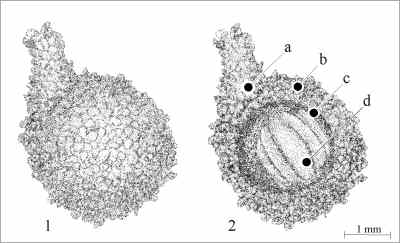 |
for the eggs. |
A search for eggs deposited in the sand produced interesting sand balls at each place of oviposition (Fig. 6.1). These sandy objects have an average diameter of 4.5 mm and are tapered on the upper side (Fig. 6.2a). The outer surface is made of 3-5 layers of sand grains, which are fixed strongly with an unknown glue (Fig. 6.2b). Only the sand grains of the projection on the upper surface are loosely attached and detach easily at the base. The inside of this sand container is covered with a silky lining (Fig. 6.2c) and an average of 5 eggs is deposited in the centre (minimum: 1, maximum: 6). These eggs are white, long-oval, with a smooth surface and lined up towards the upper projection (Fig. 6.2d). The glue cementing the sand grains is certainly different from normal excrement, which is yellowish and does not adhere to sand grains.
Creation of such sand containers, or "cocoons" was first described in the case of Antipalus varipes (Meigen, 1820) by Musso (1981). There are some differences between the two: the sand "cocoon" of A. varipes encloses only one egg and has no lining. The outer layer of sand grains is missing along one longitudinal side of the egg.
Musso (1981) also observes that certain Bombyliidae have a perivaginal pouch in which they cover their eggs with sand., first described by Schremmer (1964) as "Sandkammer". Zaitzev (1989) called these Bombyliidae the Psammophoridea group. The ovipositor of A. varipes is of an unusual shape for the subfamily Asilinae, whereas D. diadema (subfamily Dasypogoninae) has an normal ovipositor with acanthophrites. It is not known if the sand "cocoon" is produced before the oviposition, but the short oviposition time (5-10 sec.) makes this probable. It is speculated that the function of these sand "cocoons" is the protection of the eggs from the high temperature (which can be as high as 38°C at 1 cm below the surface) and the dryness. In addition they provide a camouflage which protects them from predators.